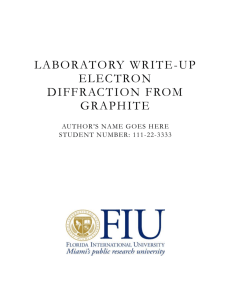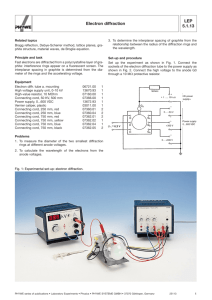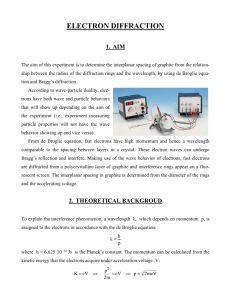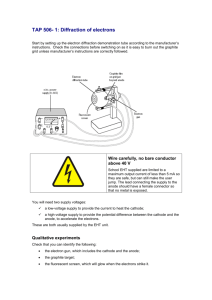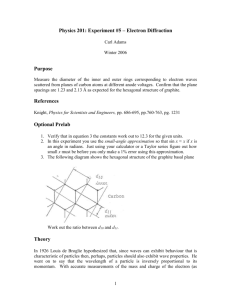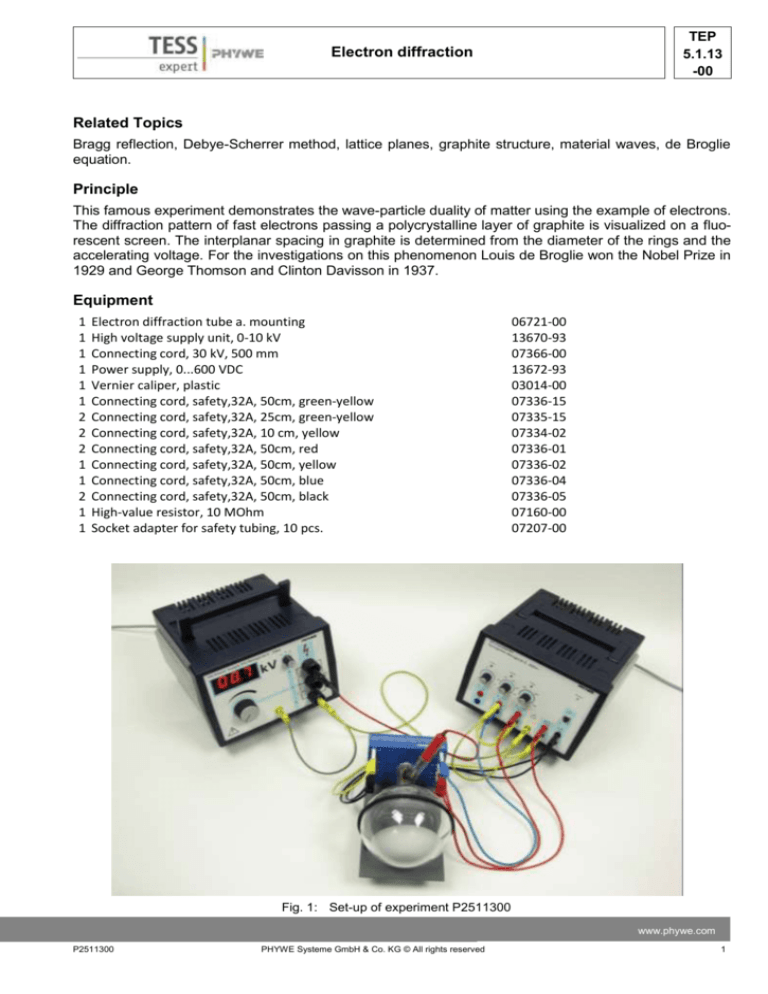
TEP
5.1.13
-00
Electron diffraction
Related Topics
Bragg reflection, Debye-Scherrer method, lattice planes, graphite structure, material waves, de Broglie
equation.
Principle
This famous experiment demonstrates the wave-particle duality of matter using the example of electrons.
The diffraction pattern of fast electrons passing a polycrystalline layer of graphite is visualized on a fluorescent screen. The interplanar spacing in graphite is determined from the diameter of the rings and the
accelerating voltage. For the investigations on this phenomenon Louis de Broglie won the Nobel Prize in
1929 and George Thomson and Clinton Davisson in 1937.
Equipment
1
1
1
1
1
1
2
2
2
1
1
2
1
1
Electron diffraction tube a. mounting
High voltage supply unit, 0-10 kV
Connecting cord, 30 kV, 500 mm
Power supply, 0...600 VDC
Vernier caliper, plastic
Connecting cord, safety,32A, 50cm, green-yellow
Connecting cord, safety,32A, 25cm, green-yellow
Connecting cord, safety,32A, 10 cm, yellow
Connecting cord, safety,32A, 50cm, red
Connecting cord, safety,32A, 50cm, yellow
Connecting cord, safety,32A, 50cm, blue
Connecting cord, safety,32A, 50cm, black
High-value resistor, 10 MOhm
Socket adapter for safety tubing, 10 pcs.
06721-00
13670-93
07366-00
13672-93
03014-00
07336-15
07335-15
07334-02
07336-01
07336-02
07336-04
07336-05
07160-00
07207-00
Fig. 1: Set-up of experiment P2511300
www.phywe.com
P2511300
PHYWE Systeme GmbH & Co. KG © All rights reserved
1
TEP
5.1.1300
Electron diffraction
Tasks
1. Measure the diameter of the two smallest diffraction rings at different anode voltages.
2. Calculate the wavelength of the electrons from the anode voltages.
3. Determine the interplanar spacing of graphite from the relationship between the radius of the diffraction rings and the wavelength.
Set-up and Procedure
Set up the experiment as shown in Fig. 1. Connect the sockets of the electron diffraction tube to the
power supply as shown in Figs. 1 and 2.
Fig. 2: Electrical connections for the experiment.
Set the Wehnelt voltage G1 and the voltages at grid 4
(G4) and G3 so that sharp, well defined diffraction rings
appear. Read the anode voltage at the display of the HV
power supply. (Please note that the voltage on the anode approximately corresponds to the voltage shown on
the display of the power supply only if the tube current is
small << 1mA. Otherwise the voltage drop on the 10 MΩ
resistors cannot be neglected. Make sure that the
Wehnelt voltage is set to -50 V. Smaller absolute values
of Wehnelt voltages lead to significant tube current increase and thus strong voltage drop on the resistor.) To
determine the diameter of the diffraction rings, measure
the inner and outer edge of the rings with the vernier
caliper (in a darkened room) and take an average. Note
that there is another faint ring immediately behind the
Fig. 3: Set-up and power supply to the electron diffracsecond ring.
tion tube.
2
PHYWE Systeme GmbH & Co. KG © All rights reserved
P2511300
TEP
5.1.13
-00
Electron diffraction
Theory and evaluation
In 1926, De Broglie predicted in his famous hypothesis that particles should also behave like waves. This
hypothesis was confirmed concerning electrons three years later independently by George Thomson and
Clinton Davisson, who observed diffraction patterns of a beam of electrons passing a metal film and a
crystalline grid, respectively. All of them won the Nobel prize for their investigations, De Broglie in 1929
and Thomson and Davisson in 1937.
Electron diffraction is used to investigate the crystal structure of solids similar to X-Ray diffraction. Crystals contain periodic structural elements serving as a diffraction grating that scatters the electrons in a
predictable way. Thus, the diffraction pattern of an electron beam passing through a layer of a crystalline
material contains information about the respective crystal structure. In contrast to X-Rays, electrons are
charged particles and therefore interact with matter through coulomb forces providing other information
about the structure than X-ray diffraction.
To explain the interference phenomenon of this experiment, a wavelength λ, which depends on momentum, is assigned to the electrons in accordance with the de Broglie equation:
𝜆=
ℎ
(1)
𝑝
where h = 6.625 · 10–34 Js, Planck’s constant.
The momentum can be calculated from the velocity ν that the electrons acquire under acceleration voltage UA:
1
2
𝑚𝑣 2 =
𝑝2
2𝑚
= 𝑒 ∙ 𝑈𝐴
(2)
The wavelength is thus
𝜆=
ℎ
√2me∙UA
(3)
where e = 1.602 · 10–19 As (the electron charge)
and m = 9.109 · 10–31 kg (rest mass of electron).
At the voltages UA used, the relativistic mass can
be replaced by the rest mass with an error of only
0.5%. The electron beam strikes a polycrystalline
graphite film deposite on a copper grating and is
reflected in accordance with the Bragg condition:
2𝑑 sin 𝜃 = 𝑛 ∙ 𝜆, 𝑛 = 1,2,3 … (4)
where d is the spacing between the planes of the
carbon atoms and θ is the Bragg angle (angle between electron beam and lattice planes).
Fig. 4: Crystal lattice of graphite.
In polycrystalline graphite the bond between the individual layers (Fig. 4) is broken so that their orienwww.phywe.com
P2511300
PHYWE Systeme GmbH & Co. KG © All rights reserved
3
TEP
5.1.1300
Electron diffraction
tation is random. The electron beam is therefore
spread out in the form of a cone and produces interference rings on the fluorescent screen. The
Bragg angle θ can be calculated from the radius of
the interference ring but it should be remembered
that the angle of deviation α (Fig. 3) is twice as
great:
α = 2θ.
From Fig. 3 we read off
sin 2𝛼 =
𝑟
𝑅
(5)
Fig. 5 : Graphite planes for the first two interference
rings.
where R = 65 mm, radius of the glass bulb.
Now, sin 2𝛼 = 2sin α cos 𝛼
For small angles α (cos 10° = 0.985) can put
sin 2𝛼 ≅ 2sin α
(6)
so that for small angles θ we obtain
sin 2𝛼 = sin 4θ ≅ 4 sin θ (6a)
With this approximation we obtain
𝑟=
2𝑅
𝑑
∙𝑛∙𝜆
(7)
The two inner interference rings occur through reflection
from the lattice planes of spacing d1 and d2 (Fig. 5), for
n = 1 in (7).
The wavelength is calculated from the anode voltage in
accordance with (3):
𝑈𝐴
𝑘𝑉
4.00
4.50
5.00
5.50
6.50
4
𝜆
𝑝𝑚
19.4
18.3
17.3
16.5
15.2
Fig. 6: Radii of the first two interference rings as a function of the wavelength of the electrons.
PHYWE Systeme GmbH & Co. KG © All rights reserved
P2511300
Electron diffraction
7.00
7.40
TEP
5.1.13
-00
14.7
14.3
Applying the regression lines expressed by
Y = AX + B
to the measured values from Fig. 6 gives a slopes
A1 = 0.62 (2) · 109
A2 = 1.03 (2) · 109
and the lattice constants
d1 = 211 pm
d2 = 126 pm
Fig. 7: Interplanar spacing in graphite
d1 = 213 pm; d2 = 123 pm; d3 = 80.5 pm;
d4 = 59.1 pm; d5 = 46.5 pm.
in accordance with (7),
𝑻𝒊
𝝀
= 𝑨𝒊 =
𝒅𝒊 =
𝟐𝑹
𝒅𝒊
and
𝟐𝑹
𝑨𝒊
Notes
-
The intensity of higher order interference rings is much lower than that of first order rings. Thus, for
example, the second order ring of d1 is difficult to identify and the expected fourth order ring of d1
simply cannot be seen. The third order ring of d1 is easy to see because graphite always has two lattice planes together, spaced apart by a distance of d1/3. (Fig. 7) In the sixth ring, the first order of ring
of d4 clearly coincides with the second order one of d2.
Radii (mm) calculated according to (4) for the interference rings to be expected when UA = 7 kV:
-
n=1
n=2
n =3
n=4
d1
8.9
17.7
26.1
34.1
d2
15.4
29.9
d3
23.2
d4
31.0
d5
38.5
The visibility of high order rings depends on the light intensity in the laboratory and the contrast of the
www.phywe.com
P2511300
PHYWE Systeme GmbH & Co. KG © All rights reserved
5
TEP
5.1.1300
-
6
Electron diffraction
ring system which can be influenced by the voltages applied to G1 and G4.
The bright spot just in the center of the screen can damage the fluorescent layer of the tube. To avoid
this reduce the light intensity after each reading as soon as possible.
PHYWE Systeme GmbH & Co. KG © All rights reserved
P2511300

